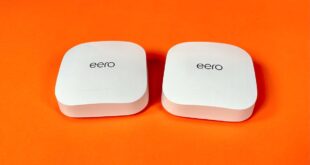Tribit XSound Go: Despite being on the market for several years, the Tribit XSound Go remains one of the top Bluetooth speakers for the money. Besides sounding decent for streaming your favorite music and more, this affordable Bluetooth speaker is also fully waterproof. It has had some small upgrades over the years.
JBL Pulse 5: JBL’s Pulse speaker is now in its fifth generation, and both the sound quality and 360-degree light show have been improved. JBL has “expanded the transparent outer body” so the customizable light show looks more impressive. (There’s a companion app for iOS and Android that allows you to alter the colorful lighting effects.) The speaker is also IP67 dustproof and waterproof, and it offers up to 12 hours of battery at moderate volume levels.
Anker Motion Boom: Anker’s more expensive Soundcore Motion Boom Plus (see above) is a substantial sound upgrade over the original Motion Boom but this model is still a good mini boom box for the money. Equipped with a handle and weighing a little over 4 pounds, the speaker reminds me of one of those giant flashlights or “floating lanterns” that were in vogue about 30 years ago. For the record, the Motion Boom really does float: It’s fully waterproof with an IPX7 rating.
UE Hyperboom: Ultimate Ears’ Boom Bluetooth speakers come in a few different sizes, but none of them are as big as the Hyperboom. A supersize wireless speaker that tips the scales at a hefty 13 pounds, the Hyperboom makes the UE Megaboom 3 look unquestionably puny. It’s not cheap, but its sound quality is better than a lot of the jumbo portable speakers on the market right now. Read our review.
Marshall Willen: Marshall’s little mono Willen speaker is similar to Bose’s SoundLink Micro and other micro speakers like the Tribit StormBox Micro 2. Also like those speakers, it has an integrated strap on its base so you can clip it onto a backpack or even to your bike’s handlebars. Its 2-inch full-range driver and two passive radiators put out more sound than you’d think it would for its tiny size, and it offers decent clarity as well as just enough bass to avoid sounding tinny (you can choose from three preset sound modes).
Tribit StormBox: The StormBox looks like a cross between a UE and a JBL speaker. We suspect that’s not an accident. This fully waterproof speaker costs significantly less than the JBL Flip 5 and Flip 6 and produces a bigger sound. Its rechargeable battery offers up to 20 hours of battery life for playing music and more. Tribit’s XSound speakers are probably a better value, but the StormBox is more stylish.
Bang & Olufsen Beosound A1 (2nd Gen): A couple of years ago, Bang & Olufsen upgraded its dome-shaped aluminum-clad A1 speaker with improved battery life, better speakerphone performance (it now has a three-microphone array) and slightly improved sound. It’s not only the smallest wireless speaker from the Danish company, it’s technically the most affordable.
Sonos Roam: Available in white or black for $179, the Roam is currently the smallest and most affordable Sonos speaker (if you don’t count those $99 Sonos-compatible Symfonisk Ikea Wi-Fi bookshelf speakers), although it’s fairly expensive for a mini wireless speaker. This Sonos Roam model, like the bigger Sonos Move 2 portable speaker, is equipped with both Bluetooth and Wi-Fi and can tap into an existing Sonos multiroom audio system and link with other Series 2-compatible Sonos speakers.
Anker Soundcore Motion Plus: Anker’s Soundcore Motion Plus came out in 2019, but it remains one of the best-sounding speakers for around $100. It’s larger than many mini Bluetooth speakers, but it’s still compact. It manages to sound fuller than much of the competition in its price range, with bigger bass, more volume and better clarity. It’s also fully waterproof (IPX7-rated) and has support for the aptX streaming codec for devices like Samsung’s Galaxy phones that support it.
Bang & Olufsen Beosound Explore: While it’s a little overpriced for the sound quality it delivers, the Beosound Explore is a good little speaker with a sleek, eye-catching design. It’s fully waterproof and dustproof (IP67 rating), and offers excellent battery life, with up to 27 hours of music listening at moderate volume levels.
Monoprice Soundstage 3: Monoprice tends to make generic-looking electronic products, and its understated Soundstage 3 Bluetooth speaker probably isn’t going to wow you with its design although its minimalist aesthetic has its appeal. I wouldn’t buy this speaker at its list price of $250, but it’s often discounted to closer to $150, where it’s a good value thanks to its ability to play big sound with strong bass and decent clarity, with 50 watts of power that drives a 5.25-inch “concave aluminum cone woofer” flanked by two 1-inch silk-dome tweeters. It also has good connectivity options, including digital optical, 3.5mm analog and RCA analog wired inputs that allow you to connect your television or another stereo component. There’s also a sub-out port.
Tribit XSound Mega: Over the last few years, Tribit has made several Bluetooth speakers that deliver a lot of boom for the buck. Add its new XSound Mega to the list. Tribit is billing the XSound Mega as more of an outdoor speaker — a lanyard is included for toting it around as a sort of mini boombox — but it works just fine indoors. It has an LED light show that you can turn on or off and there are three EQ settings for sound: XBass, Music and Audiobook. Additionally, it can be used as a power bank to charge your mobile devices.
Other Bose products we tested
Bose QuietComfort Ultra Headphones: While Bose’s new flagship QuietComfort Ultra Headphones may not be a huge upgrade over the company’s Noise Cancelling 700 headphones, they feature a more premium design along with Bose’s new Immersive Audio feature, which delivers some sound-quality enhancements. Along with excellent sound and great noise canceling, the QC Ultra Headphones are also superb for making calls, with top-notch background noise reduction.
Bose QuietComfort Ultra Earbuds: While the QC Ultra Earbuds aren’t a major upgrade over Bose’s excellent QC Earbuds 2 that were released in 2022, they’re definitely a little better. They should fit most ears very well, and they feature superb noise canceling, arguably the best out there. And a natural-sounding transparency mode with a new ActiveSense feature kicks in some ANC should the sound get too loud around you (it’s sort of similar to the AirPods Pro’s Adaptive Audio feature). They also sound slightly better overall, with a touch more clarity, and their new Immersive Audio feature opens up the sound a bit.
Bose QuietComfort Headphones: When Bose released its new flagship QuietComfort Ultra Headphones, it also replaced the QuietComfort 45s with a new, slightly updated model simply called the QuietComfort Headphones. Like the QC 45s, this model carries on the very comfortable tried-and-true legacy QuietComfort design that’s been around for a few generations that a lot of people continue to love.
Bose Ultra Open Earbuds: The Bose Ultra Open Earbuds have one of the most unusual designs of any earbuds I’ve tested over the last several years. They literally clip onto the side of your ears, kind of like earrings, and their open design has micro speakers that fire sound into your ears while still being able to hear what’s happening around you.
Bose Sport Open Earbuds: Geared toward runners and bikers who want their ears open to the world for safety reasons — or to people who don’t like to have any sort of bud in their ears — they sound surprisingly good. I ended up liking them, but their design isn’t for everybody, and how comfortable you find them will determine how much you like them. They’re currently available in the US for $200. (There’s no official international pricing yet, but that’s about £150 or AU$260.)
Bose QuietComfort 45: The QuietComfort 45 has virtually the same design as its predecessor, the QuietComfort QC35 version 2 (henceforth known as the QC35 II). It has the same drivers, according to Bose, and the buttons are in the same place. However, there are small but notable changes. First off, these thankfully have USB-C instead of micro-USB. With USB-C becoming the de facto standard for charging — except for certain Apple devices — most new devices offer USB-C charging, simplifying our cable situation.
 synnbiob
synnbiob


